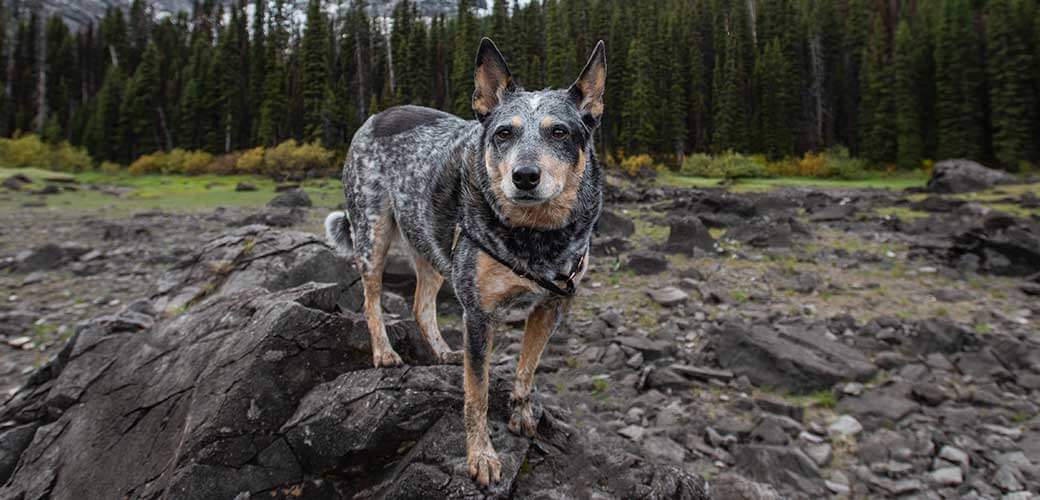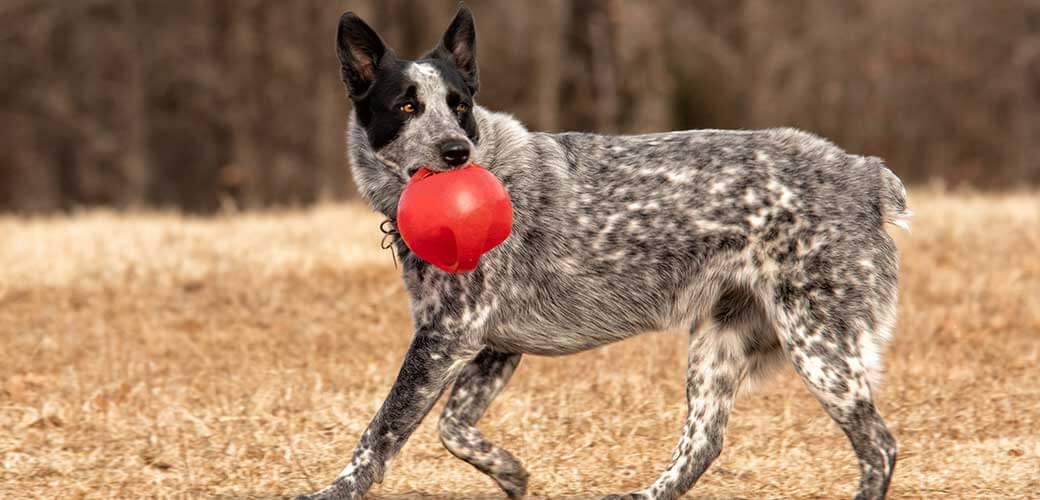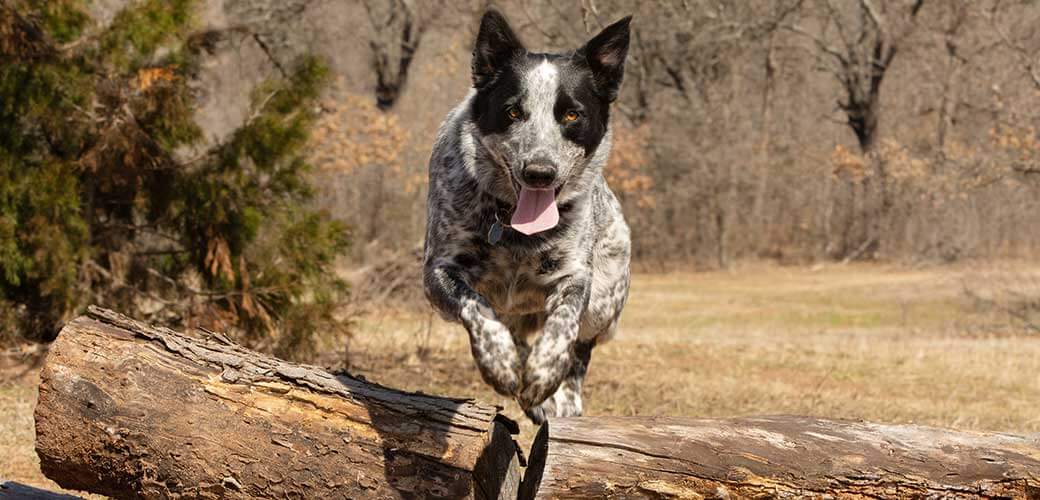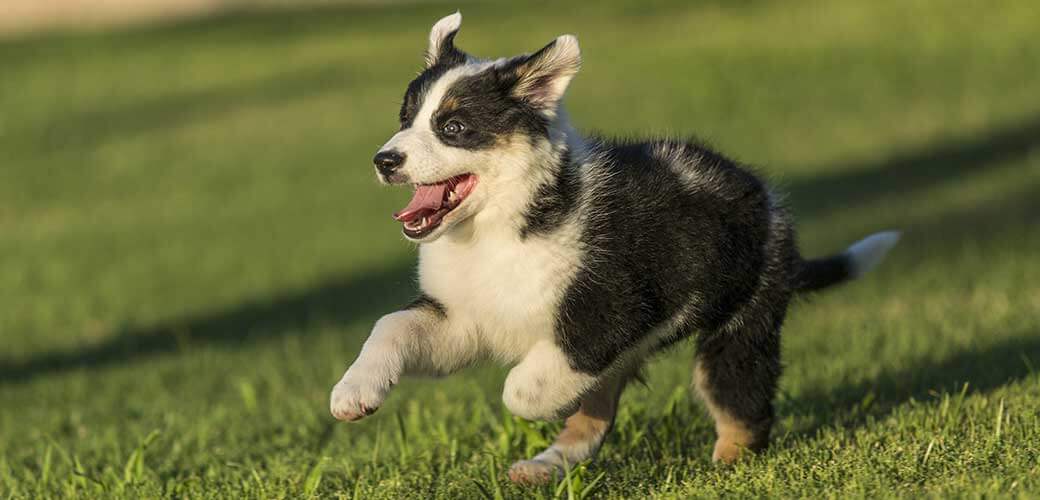Texas Heelers are strikingly beautiful dogs that share all of the best features of their Australian cattle dog and Australian shepherd parents. They are hardworking, active, loyal, protective, and playful and make excellent dogs for working households.
For anyone that has found themselves looking at Texas Heeler puppies, we would suggest taking a look over this quick guide to familiarise yourself with the breed and understand what you might expect from your feisty new pup.
Texas Heeler Breed Overview
Just as a general rule of thumb, it’s worth noting that cross breeds can vary quite dramatically in their appearance because there’s no way of knowing which parent they will take after more or whether they’ll be an even mix of the two.
Like humans, you can get Texas Heelers that look and act just like their fathers or mothers. This is the risk you take when adopting a mixed-breed Texas Heeler puppy. But as a rough guide as to what you might expect, here’s a table of the variations in appearance, weight, height, and temperament that your Texas Heeler could inherit:
What Is a Texas Heeler?
A Texas Heeler combines two herding dog breeds – Australian Shepherds and Australian Cattle Dogs (ACDs). Because they are both herding dogs, Texas Heelers make spectacular heading dogs themselves. Additionally, they tend to have a good mix of muscular power from the cattle dog parents (which ideally needs to be muscular to herd cattle properly), and the lean light footedness of their shepherd parent.
As a mixed breed dog, there’s no knowing exactly what a Texas Heeler puppy will be like until it is fully developed, but by looking at each of the parent breeds individually, it is possible to deduce the look and behavior they are likely to exhibit.
Common Alternative Names For Texas Heelers
Because they are a mixed breed, Texas Heelers go by various names that combine either the names of the two parent breeds or their breeding location. “Texas Heeler” comes from the fact that this particular breed is most commonly bred in Texas. Here are a few other names they go by:
- Texas Blue Heeler
- Border Heeler Aussie mix
- Cattle Dog Australian Shepherd
- Aussie Blue Heeler
- Aussie Shepherd Blue Heeler mix
- Australian Shepherd mix
- Aussie Heeler mix
- Australian Heeler
Texas Heeler Facts

- Texas Heelers are crossed between two herding breeds, making them excellent herding dogs.
- Texas Heelers are not recognized by the American Kennel Club (AKC), but they are recognized by the Dog Registry of America (DRA), the Animal Research Foundation (ARF), and the American Canine Hybrid Club (ACHC).
- They form strong bonds with their owners and are quite protective of their families.
- They are not suitable for owners of small homes or apartments.
- They are highly intelligent dogs with a lot of energy and require regular exercise and stimulation.
- Texas Heelers can vary greatly in weight, height, and appearance.
Texas Heeler Breed History
Texas Heelers are relatively new additions to the world of dog breeding. As a result, there isn’t much information available about their origins as an individual breed. Therefore, we can only deduce their history from the histories of their respective parent breeds, the history of dog breeding in general, and the trends of cross-breeding over the years.
There is every possibility that the creation of the Texas Heeler could have been a natural occurrence as the two rather similar breeds became attracted to one another in the wild. This could have led to the discovery of the cross-breed, inspiring their creation as a purpose-bred breed. However, there’s no way of knowing this for sure, though it would certainly account for the limited amount of information on offer regarding the overall history of Texas Heelers.
The popularity of the Texas Heeler would suggest that they have been purpose-bred for some time. It is likely that the intentional breed of Texas Heelers dates back to the turn of the century when hybrid dog breeds started to be more readily appreciated and desired throughout the dog market.
Interestingly, Lucy Guynes first registered the Heeler as a breed by the Dog Registry of America (DRA) in 1970. While the Aussie Cattle Dog didn’t gain recognition in America until 1980, and the Aussie Shepherd wasn’t recognized until 1993.
The Texas Heeler Appearance

Texas Heelers are a combination of two beautiful breeds – the Australian cattle dog and the Aussie Shepherd dog (also known as the Queensland Heeler). Texas Heelers can vary quite a bit in appearance. They might take on the more muscular appearance of their cattle dog parent or perhaps be more streamlined and lean like the shepherd.
Their physical appearance and temperament could help to determine what jobs they would be best suited to if a working household were to adopt one. It may even be that rather than having them work, they could participate in dog sports best suited to their physicality.
Common Physical Texas Heeler Traits
When looking at the two parent breeds, Australian Shepherds are a relatively slim build – lean for maneuverability and light-footed to work their way around a flock of sheep easily. Contrastingly, Aussie Cattle Dogs are muscular and powerful – physical traits necessary for herding livestock.
Most Texas Heeler owners tend to find that their Texas Heeler puppies often develop a good mix of the two – usually with stronger forequarters and a strong neck accompanied by an overall slim, long-legged build and narrower face as seen on the Aussie Shepherd.
Typical Texas Heeler Coat Types and Colors
Australian Shepherds have thick, long, flowing coats much like the border collie breed. Blue Heelers (ACDs) have thick, short, wiry coats. Most Texas Heelers generally inherit a combination of the two, resulting in softer short to medium-length coats that maintain the thickness of the two parent breeds.
Both breeds have a brilliant variety of colors that their coats come in, which could be inherited by a Texas Heeler. The colors often seen in a Texas Heeler’s coat include:
- Blue
- Blue Mottled
- Red Speckled
- Red Mottled
- Blue Speckled
- Black
- Blue Merle
- Red
- Red Merle
- Blue Ticked
The Size Range of Texas Heelers
There isn’t a huge difference in size between the two breeds, but it’s noticeable. Generally speaking, Texas Heelers are a medium-sized breed that lands comfortably in the middle. However, there is every possibility that they could be as short as 17 inches in height or as tall as 23 inches, depending on their sex and which parent they take after.
Additionally, their weight is quite a big difference, ranging from 35 pounds to 65 pounds! Considering ACDs are particularly muscular, it makes sense that the difference in weight is more significant than you’d think when considering the small difference in height between the two parent breeds.
The Texas Heeler Personality
Texas Heelers are highly intelligent, determined, focused, loyal, and hard-working dogs. It’s these personality attributes that make them such fantastic working dogs. Texas Heeler puppies are receptive to learning new commands and eager to please (for the most part), though, with intelligent dogs, it still takes a firm hand to make the best of their training.
Temperament
The Texas Heeler temperament is typically characterized as hard-working, loyal, playful, protective, alert, intelligent, adaptable (though this can vary depending on which of the parents the dog takes after), and cautious of strangers (again, this depends on which of the parents they take the most after).
We always advise new dog owners to ensure their pup is thoroughly socialized from a young age, regardless of its breed. However, with some breeds, we advise it more strongly. Breeds with strong natural herding or hunting instincts should always prioritize early socialization.
Other Pets and Animals
It’s not advisable to have a blue heeler with other pets, especially small animals, as they are very active and can be quite intimidating to other dogs (especially small breeds), or cats. This is not to say that they won’t get along, simply that their boisterous personalities might not mesh well with other, more mellow, household pets.
Entertainment
The Texas Heeler can be difficult to care for as a home dog if you’re unaware of its needs. This is an extremely active breed physically and mentally, and active dogs require an active lifestyle. That means walks, runs, work, tasks, training, and even toys to keep them mentally stimulated in your downtime, such as puzzle treat toys and chaser toys.
With Children
Texas Heelers generally develop strong family bonds and can become quite protective of children. Their bonds make them good family dogs, and their urge to play to pass the time – is something young children know how to do well. However, it is vitally important that children who come in contact with dogs are taught how to handle dogs properly to avoid incidents – this goes for every breed.
Texas Heeler Care
Fortunately, caring for a Texas Heeler is a relatively simple affair so long as you can keep up with their exercise demands. They’re pretty strong, healthy dogs and don’t typically require special dog food, so there’s no need to worry too much about your dog’s diet. However, a few helpful pointers on their basic care requirements are always helpful.
Grooming
The main thing to remember is that the Texas Heelers have thick coats. They may not necessarily be long (though possible), but at the very least, they require plenty of brushing 2-4 times a week to maintain basic hygiene, remove debris, and remove loose fur.
Texas Heelers shed a lot during shedding seasons, dropping large amounts of fur in a very short space of time. If they’re not brushed regularly enough, then their coat matures in the underlayers is still possible.
Exercise

As we’ve previously discussed, Texas Heelers are massively energetic dogs with a high demand for exercise. Even as adult dogs, they maintain that energy level for years. To sum up some examples of ways to burn off some of that excess energy, we’ve provided a quick list below of the ideal exercise activities for Texas Heelers:
- Work Tasks
- Dog Park Visits
- Obedience Training
- Agility Training
- Basic Training / New Commands
- Playtime Games
- Hiking
- Biking
- Swimming
Texas Heeler Health
Texas Heelers are quite healthy dogs as mixed breeds, in general, tend to do better than their purebred parents because mixing their genetics makes the baby less likely to develop predispositions to hereditary health issues. That doesn’t mean that they’re impervious to health problems, however. Listed below are some of the money common health problems that the parent breeds experience that can be experienced by a Texas Heeler:
- Hip Dysplasia – This condition causes the hip joints to dislocate easily. This can lead to lameness, immobility, and significant pain and discomfort. There are ways to treat hip dysplasia with medication, physiotherapy, and in more severe cases, surgery. However, it can’t be completely cured.
- Hyperthyroidism – Hyperthyroidism typically impacts a dog’s ability to maintain steady body weight. Hyperthyroidism also impacts their energy production, resulting in a dog that can appear hyperactive. This hyperactivity can also trigger anxiety as it causes their heart rate to increase. Fortunately, hyperthyroidism is treatable with the right medication.
- Progressive Retinal Atrophy – PRA affects your dog’s vision and is a very common condition seen throughout most dog breeds, much like with humans. It often gets worse as they get older, more seriously affecting senior dogs, and can eventually lead to partial or full blindness. Unfortunately, there is no treatment for this condition.
- Arthritis – Arthritis causes the joints to stiffen painfully. A typical problem with most dogs, not just this breed group is the impact on the joints throughout life that can trigger joint conditions as a result of wear and tear. Unfortunately, there is no cure for arthritis, but there are some treatments that can help to ease some of the symptoms.
- Lipoma – This type of benign tumor develops under the skin and is made up of fat. The tumors can be safely removed, however, once one tumor develops it is highly likely that more will follow.
- Deafness – Loss of hearing is a problem often seen with Blue Heelers. Your Texas Heeler could start to lose its hearing as it ages. You can recognize hearing loss through certain behavioral traits such as how well they respond to being called. Treatment is possible, though it does depend on the cause of the deafness.
Even though Texas Heelers are significantly more likely to live a healthier lifestyle than either of their parent breeds, there’s no guarantee that they won’t have any problems. Always remain observant and mindful of your pup if you want to nip health issues before they develop too far.
Where Can I Get a Lab Blue Heeler Mix?
Because the Texas Heeler is not officially recognized by the American Kennel Club, it can be quite hard to find a reputable breeder who specifically breeds these mixed-breed puppies as you won’t be able to look on the AKC marketplace – which only contains screened, checked, and registered breeders.
We would recommend speaking to breeders of either of the purebred parents or rescue organizations for these breeds that may be able to provide some information to help with your search.
Blue Heelers tend to be quite sought after due to their exceptional capabilities as herding dogs. Therefore Blue Heeler mixed puppies are seen as a more affordable alternative meaning Blue Heeler breeders may be aware of alternative breeder options.
Adopt Where Possible

The Australian Cattle Dog and Queensland Shepherd mix may even be found in general rescue shelters, as their very high energy and constant need for stimulation can sometimes prove difficult for inexperienced owners. This, unfortunately, leads to them being abandoned or surrendered.
Every dog deserves a second chance at life, and you may find the right dog for you is simply awaiting adoption. Adopting a dog discourages puppy mills from forced breeding and helps to keep abandonment levels down.
Frequently Asked Questions:
Q: Can Texas Heelers be service dogs?
A: Texas Heelers are certainly intelligent enough to become service dogs. They can also be eager to please, which makes service training more effective. However, they are highly energetic and require a lot of exercises, so you would need to be careful to select the right job for them so that they’re not feeling under-stimulated and restless.
Q: What is the best work for a Texas Heeler?
A: Texas Heelers are particularly well suited to herding work because the Texas Heeler’s genetic parents are both herding breeds. They make excellent working dogs, with a strong work ethic, an eagerness to please, and their ability to develop strong bonds with their owners.
Q: Are Texas Heelers aggressive?
A: Not so long as they are trained properly from an early age and raised with plenty of socialization. There is no reason a Texas Heeler would be aggressive to others unless they feel particularly threatened. Though they can be quite protective of their owners and depending on which parent they take after they become wary of strangers, just be mindful of this fact when introducing them to anyone new.
Q: Are Texas Heelers purebred dogs?
A: No. The Texas Heeler is a mixed breed made from two different purebred parents – the Australian cattle dog (aka the Blue Heeler) and the Australian Shepherd dog (aka Queensland Shepherd).

